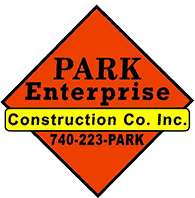Your contractor begins digging for a new sewer line at your commercial property. Crews encounter bedrock and can go no further, setting your project behind schedule.
Some problems with sewer line installation and other underground utilities are difficult to predict. But with some forethought and site analysis, a adaptable plan can be developed beforehand for a smoother outcome.
Here are Some Sewer Line Installation Roadblocks Commonly Encountered on a Job Site
1. Rock Formations
Problem: Bedrock can be uncovered during nearly any construction site preparation, depending on location and depth. Here around Columbus, OH we commonly see natural rock deposits like limestone and sandstone at shallow depths.
Solutions: Depending on the type and density of the rock strata, the hydraulic excavator may not produce sufficient force to break through it for the utility installation. Some smaller rocks and boulders are easy enough to deal with: dig around them with an excavator until you can lift or pry them out. Other times, construction crews can use a hydraulic hammer attachment to pulverize the rock and remove it in chunks. In the most severe cases, there’s no choice but to blast it out with explosives.
Knowing the rock is there before digging is particularly helpful. A contractor can commission or perform a geotechnical evaluation of the site.
2. High Groundwater
Problem: Groundwater levels in Ohio can vary by location. In some places, the water table could be dozens or even hundreds of feet below ground level. In others, contractors will run into water just several feet below the surface. High water can make any site development for construction difficult, let alone underground utility installation.
Solutions: There are several effective ways to transport or lower groundwater at your site. The easiest is sump pumping, which sucks away groundwater seeping into the utility trench. This temporary fix can allow enough dry space to work. If the volume of groundwater is more severe, it may require sometimes costly means of temporarily lowering the local table by digging relief wells, siphon drains, or deep vacuum wells, among other similar methods.
3. Existing Utilities
Problem: Excavation for water or sewer line installation sometimes uncovers infrastructure that was buried and forgotten decades ago - or longer. Running into both dormant and active utility could be an explosive problem (literally), or at least very expensive or damaging to nearby utility service.
Solutions: As we always say, “Call OUPS to avoid a utility oops.” The Ohio Utilities Protection Service will assess your property with all the tools necessary to locate and avoid existing utilities. Beginning with a good property schematic detailing previous pipe installations and other jobs also would be very helpful.
4. Not Enough Slope
Problem: While water lines are pressurized to push water wherever it needs to be in the system, sewers must run naturally downhill to remove waste. If there’s not enough grade, the sewer will not function well with gravity.
Solutions: An experienced contractor will know sewer line installation requires an adequate slope. Adequate slopes should be determined considering the pipe diameter by these widely accepted piping guidelines:
- 2 ½” or smaller requires ¼” minimum slope per foot (or 2%)
- 3” to 6” requires ⅛” minimum slope per foot (or 1%)
- 8” or larger requires 1/16” minimum slope per foot (or 0.5%)
Experienced contractors may need to install a lift station where adequate slope can’t occur naturally or through grade engineering.
5. Determining Rights of Way or Easements
Problem: This could also apply to work being done on adjacent properties, which may need access to your land. Rights of way, or easements, give utility companies the right to work on legally identified portions of private properties for community good and efficiency. If these are not known, it may require costly legal mitigation. Your municipality typically will identify and establish these areas.
Solutions: As a property owner, you should be aware on a base level what work can and cannot be done on your land. At the time of property acquisition, ensure this documentation identifying easement areas is available for you and contractors to reference.
Avoid These Common Underground Utility Installation Setbacks Preparation & Communication
Any construction project can encounter unforeseen circumstances. That includes sewer line installation and other underground utilities. A contractor with experience should know the local regulations, rules of thumb, and regional geology.
Upfront communication with your contractor and a good site survey should avoid, or at least prepare for, any installation setbacks.



